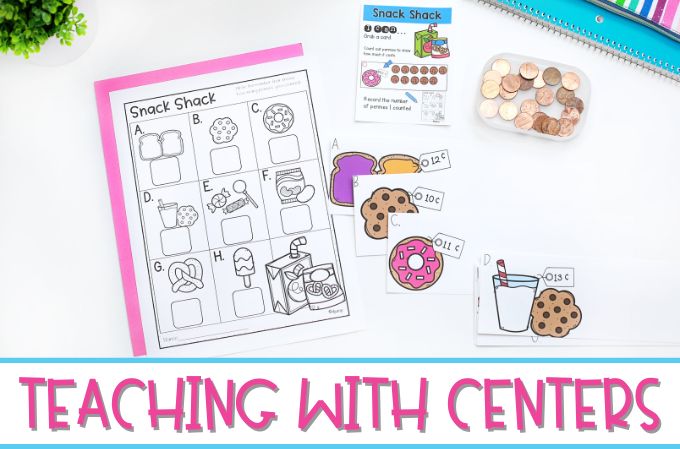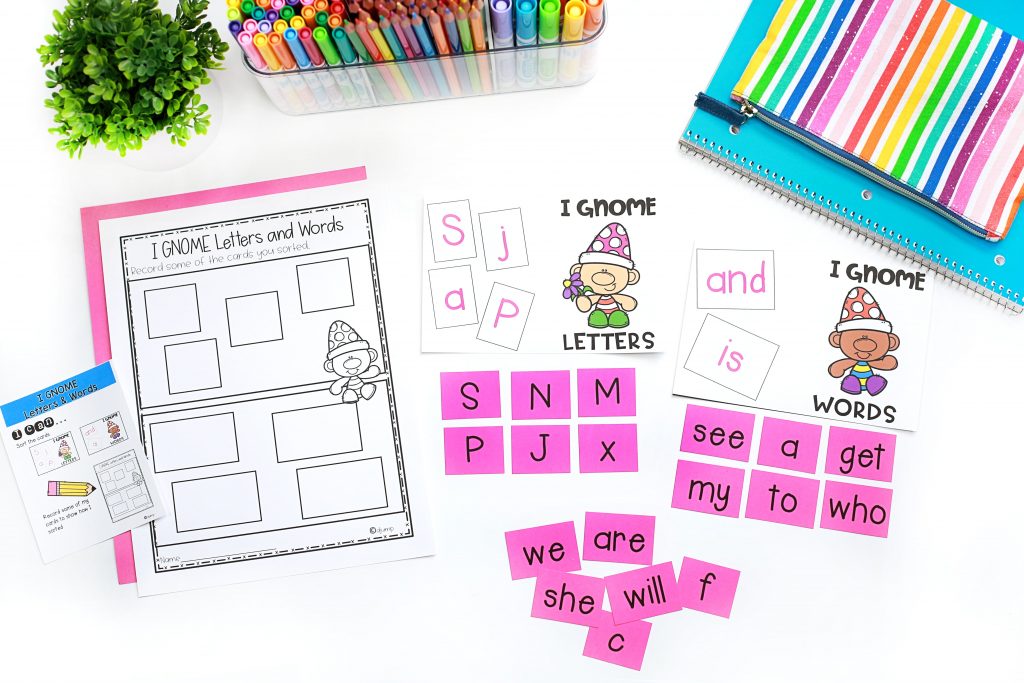The expectations for early elementary students have continued to increase over the years. This often leaves teachers looking for ways to fit additional academic skill practice into the daily routine. Teaching with centers is a great way to add engaging and meaningful review to your classroom all year long!

7 Benefits of Teaching with Centers
There are many reasons why teachers decide to use centers in their classrooms. No matter their inspiration for teaching with centers, they all experience many of the same benefits of using these learning activities.
1. Create Routine
Early elementary students thrive on consistency! Teaching with centers is an excellent way to bring a predictable learning routine to your classroom. It doesn’t take long for students to get used to the flow of the rotations each day. Classroom management is so much easier with the rhythm of this routine.
2. Save Time
It might seem like centers create a lot of extra prep work for the teachers who use them. It’s actually the opposite! Using learning centers in the classroom can save you loads of time on your weekly lesson planning. Instead of prepping a week of whole-class review activities, you can set up a few literacy or math centers that students can rotate through all week long. Some activities are also easily repeated for an entire month!
Centers activities also tend to use a similar format from concept to concept. This means that you don’t have to spend so much time introducing the activities to your students. They will get used to the format and it will be easy for them to adjust to new activities in that familiar routine.

3. Regularly Review Content
Students learn so much content during the school year! It’s important for them to regularly review previously learned concepts to keep those skills sharp! Centers are a great way to add this review to your daily routine! You can strategically choose activities based on the skills that you want the students to practice.
As educators, we know that it takes a lot of repetition for students to master academic concepts. Centers are ideal for keeping the repetition of review to become stale. With a variety of themed activities that review the same core concepts, you’re able to add a bit of novelty to the mix.
4. Increase Student Engagement
Centers usually consist of hands-on learning activities, which help increase student engagement. You can add many different manipulatives and learning tools to maximize student motivation and participation.
A common hurdle for engagement is when students are given work that is too difficult. Since centers focus on reviewing concepts that you’ve already taught, students are naturally more engaged in these activities. They feel more successful, which can motivate them to keep working!

5. Encourage Independence
Reviewing concepts with centers can help students be more engaged and motivated, but it can also encourage them to be more independent. Since the activities are at a “just right” level of difficulty, students are able to complete the tasks without a lot of assistance. This is so important for young learners!
No matter the age of the students in your classroom, they need to grow in responsibility and independence over the course of the school year. Centers are the perfect time for students to practice being more independent learners! They can problem-solve in situations when they aren’t quite sure what to do. They can complete academic tasks without an adult giving them step-by-step directions.
As Maria Montessori explains: “The greatest sign of success for a teacher is to be able to say, ‘The children are now working as if I did not exist.’” Centers allow your students to explore and learn more independently.
6. Provide Small Group Support
When your students are engaged in independent learning activities, it gives you the breathing room to work with students one-on-one or in small groups. This time allows you to focus on specific skills and assess how students understand the learning material. While you’re having much-needed instructional time with individual students, the rest of your class is engaged in purposeful learning activities.
You might choose to have students take turns rotating into a small group station with you. You might also decide not be part of the rotation and choose to work with individual students and small groups based on day-to-day needs. Either way, a centers routine can provide you with this much-needed flexibility in your daily schedule!

7. Embrace Seasonal Fun
We all know how excited our students can be about upcoming holidays or other seasonal fun throughout the year. Centers allow you to bring some of that seasonal excitement to your classroom without having to put learning on the back burner. Whether it’s themed printables or seasonal manipulatives, it’s easy to add a bit of fun to your classroom with learning centers.
You don’t have to battle the student anticipation of upcoming holidays! Instead, you can use centers to help your students channel that excitement into worthwhile learning activities. This also increases their engagement and motivation to stay on task during the learning centers.
Printable Math and Literacy Centers
I have put together a bundle of math and literacy activities to make it easy for you to experience the benefits of teaching with centers. This printable resource contains monthly literacy and math activities that are standards-based and follow the natural skill progression of the kindergarten school year.
This bundle includes all of the task cards, recording sheets, and student-friendly illustrated direction cards you’ll need to get a centers routine up and running in your classroom. Your students are going to love reviewing what they’ve learned with these engaging seasonal activities!
You can head over to my TPT store to see all of the math and literacy centers included in this bundle of No Prep Kindergarten Centers for the Year.
Save These Ideas for Teaching with Centers
Be sure to save this post if you’d like to come back to it later! Just add the pin below to your favorite teaching board on Pinterest. You’ll be able to quickly find these tips and resources for teaching with centers whenever you need them.



